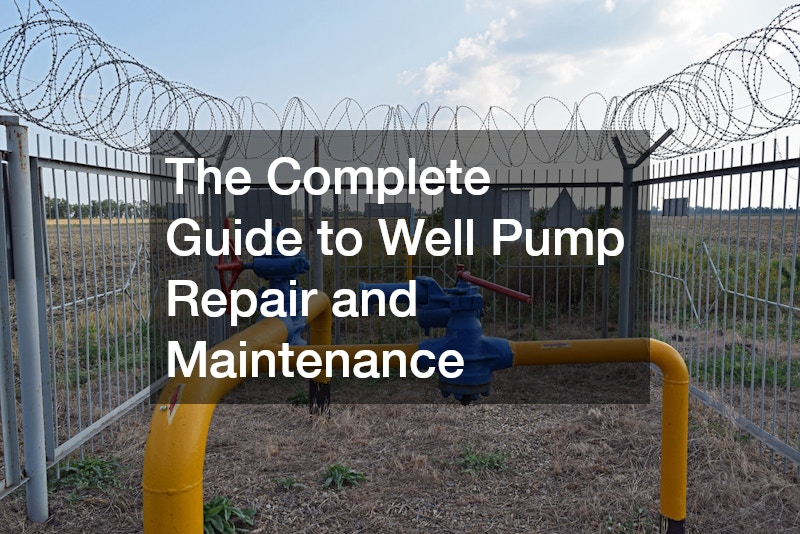
Understanding the significance of well pump repair and maintenance is crucial for ensuring a steady supply of water to your home. This guide explores essential aspects of maintaining and fixing your well pump, providing insights and practical tips along the way. A well pump functions as the heart of your home’s water supply system, and keeping it in optimal condition is imperative for minimizing disruptions.
Identifying Symptoms of Malfunction
Detecting warning signs such as irregular water flow or strange noises in early stages can prevent larger issues later. For instance, unusual sounds might indicate a problem with the motor or bearings, which, if left unaddressed, could lead to complete pump failure. Regularly checking for these symptoms can save substantial repair costs by addressing issues promptly.
Another common symptom is a significant decrease in water pressure, which may point to clogged filters or a failing pressure tank. Observing these changes allows homeowners to act rapidly, avoiding potential inconveniences. It’s also crucial to monitor any visible leaks around the pump, as these might suggest a crack in the casing or loose fittings.
Small performance declines might be overlooked initially, but recognizing them early could prevent major breakdowns. Continuous monitoring is essential for homeowners to maintain water supply efficiency. Keeping a record of recurring symptoms can help diagnose and resolve issues effectively.
Performing Basic Repairs and Adjustments
Learn simple troubleshooting steps that can be done without professional assistance, including adjusting pressure settings. Addressing minor issues like cleaning debris off the intake or checking the circuit breaker can often restore normal functionality. Ensuring the power switch is fully operational and the pump is receiving sufficient voltage is a basic diagnostic step.
Adjusting the pressure settings helps maintain consistent water pressure levels throughout the household. Misaligned pressure switches can disrupt pump performance; hence, it’s important to adjust them according to the manufacturer’s specifications. By tweaking these settings, not only can common issues be mitigated, but pump efficiency may also be enhanced.
Examining the control box and ensuring no wires are loose is another simple DIY task. Tightening connections and ensuring electronics are not exposed to moisture is crucial for safety and efficiency. These initial interventions may extend the life of the pump and reduce the need for professional repairs.
When to Call a Professional
Understanding when a problem exceeds your DIY capabilities is crucial for preventing further damage. If troubleshooting attempts fail, persisting issues like electrical faults or complex mechanical failures necessitate expert intervention. A professional assessment is valuable when symptoms are unidentifiable or seem too extensive for basic repairs.
Excessive noise or a complete water supply shutdown are warning signals that professional evaluation is needed. Technicians can perform detailed diagnostics using specialized tools to uncover hidden faults, which might be inaccessible for homeowners. By drawing on their expertise, more severe underlying issues can be resolved efficiently.
Proper repair and maintenance by trained personnel enhance well pump reliability, ensuring a consistent water supply. Entrusting professionals prevents aggravating the problem, ultimately safeguarding against costly replacements. Professionals can also offer insights into preventative measures tailored to specific well system configurations.
Scheduling Routine Inspections
Establish a maintenance schedule to check the system’s components and performance regularly. Regular inspections can uncover wear and tear that might not be visible to the untrained eye, such as small leaks or gradual motor deterioration. Consistent assessments ensure the components are functioning optimally, preventing unexpected breakdowns.
An expert-led inspection typically includes verifying electrical connections and motor operation. Checking the pressures and system calibration are standard parts of these evaluations, keeping the pump in peak condition. By adhering to a consistent maintenance timeline, the life of the well pump is considerably extended.
Well-designed maintenance routines not only sustain operational efficiency but also improve the pump’s longevity. Many manufacturers recommend annual inspections, but usage intensity might necessitate more frequent checks. These structured evaluations prevent minor issues from escalating into extensive repairs.
Checking for Electrical Issues
Issues with the electrical components can cause erratic functioning of your well pump. Electrical problems might stem from faulty wiring, corroded connectors, or failing control modules. Regularly testing the circuitry and voltage levels can highlight potential malfunctions.
A multimeter may be used to measure resistance and continuity, verifying electrical integrity within the system. Expert technicians can isolate the faulty components swiftly, recommending replacements or repairs as needed. Addressing these issues promptly prevents power surges from damaging the pump system.
Keeping the electrical systems well-maintained reduces the risk of unexpected power failures or electrical shocks. Regular inspection and maintenance preserve safety and functionality throughout the well pump system, inspiring confidence in the continued supply. Proactive care ensures consistent performance and enduring system health.
Inspecting the Pressure Tank and Switch
The tank and pressure switch are often sources of cycling problems and need regular examination. Ensuring the pressure tank maintains proper air charge levels is essential for consistent operation. Too little or too much air in the tank affects water storage and impacts the frequency of pump cycling.
Proper repair and maintenance of your well pump ensure a reliable water supply, enhance the system’s efficiency, and prolong its lifespan. By understanding troubleshooting methods, conducting regular maintenance, and recognizing problematic patterns, you can prevent issues and address any complexities that arise swiftly. Emphasizing the importance of routine care, households can avert major disruptions, safeguarding a paramount resource.



